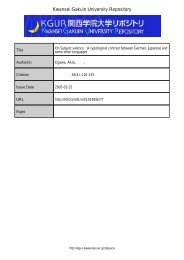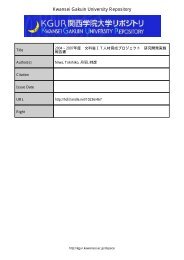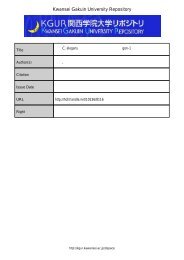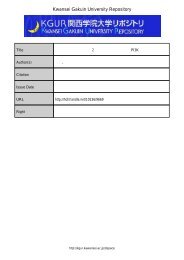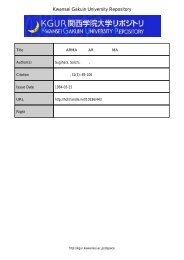Kwansei Gakuin University Repository
Kwansei Gakuin University Repository
Kwansei Gakuin University Repository
Create successful ePaper yourself
Turn your PDF publications into a flip-book with our unique Google optimized e-Paper software.
In this study, we examine empirically the effects of industry-, region-, firm- and<br />
entrepreneur-specific characteristics on new-firm exit according to forms of exit, us-<br />
ing a sample of firms founded in Japan during 1997–2004. Then, we provide evidence<br />
that these effects vary significantly between forms of exit, by estimating a compet-<br />
ing risks proportional hazards model. It is expected that this paper contributes to<br />
the development of research on industry dynamics and provides important ideas for<br />
policy makers.<br />
The remainder of the paper is organized as follows. In Section 2, we describe<br />
the background and related literature of this paper. Section 3 explains the data<br />
and method employed in the analysis. Our model of the determinants of exit is<br />
discussed in Section 4. The empirical results are presented in Section 5. The final<br />
section includes some concluding remarks.<br />
2. Background and related literature<br />
In the field of industrial organization, scholars have realized that entry and exit<br />
play an essential role in industry dynamics. Entry and exit, which are often re-<br />
garded as ‘turbulence’ in the market, are vital to maintaining vigorous competition<br />
in industries. In fact, a large number of empirical studies have provided insights<br />
into the determinants of entry and exit; for example, Dunne et al. (1988) showed<br />
the patterns of entry and exit over time in US manufacturing industries. 1 Among<br />
new firms, some firms survive and grow in the market through the learning process.<br />
Because new firms are expected to contribute to the development of industries, it<br />
is beneficial to promote the creation of new firms with growth potential. On the<br />
other hand, some firms are forced to exit under competitive pressure. Entry and exit<br />
play a key role in maintaining the natural selection mechanism through competition,<br />
1 For a survey of evidence on entry and exit, see, for example, Siegfried and Evans (1994), Carree<br />
(2006), and Santarelli and Vivarelli (2007). For more discussions on entry and exit, see also Geroski<br />
(1995) and Caves (1998).<br />
3



